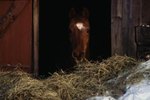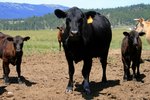Things You'll Need
Beef cattle nutrient requirement tables
Feedstuff composition tables
As ruminants, or animals with a four-compartment stomach, beef cattle primarily consume roughage feeds such as hay and pasture. The nutrient requirements of beef cattle differ according to the sex, age, production and daily gain of the animal. The nutrient content of hay differs due to the type of vegetation and the age of the plant when harvested. To successfully mix and feed hay rations for cattle, the nutrient requirements of the cattle, and the nutrient content of the feed are important information.
Determine the nutrient requirements of the beef cattle. Use tables from the resources below to find the crude protein and TDN content of the feed. TDN or total digestible nutrients is an indication of the energy level.
Find the types of hay available for purchase. Alfalfa is grown throughout the U.S. Some areas produce brome or prairie hay, types of grass hays, or oat hay. Compare the hay prices to determine the best buy.
Check the hay quality. Alfalfa hay that is cut during the bud stage has a much higher crude protein and TDN content than alfalfa hay cut during full-bloom. The same is true for grass hay. Cut during the early stage, the hay has a higher nutrient content than hay cut from mature plants.
Estimate the nutrient content of the hay by consulting online feed composition tables. For a more accurate determination, send a sample of the feed to a testing laboratory.
Consider alfalfa hay if a higher level of protein and energy is required. Typical mid-bloom alfalfa hay contains about 16 percent crude protein and 56 percent TDN. Grass hay contains about 8.4 percent crude protein and 53 percent TDN.
Compare the requirements of the beef cattle with the nutrient content of the hay. For example, a mature beef cow in the mid trimester of pregnancy requires about 7 percent crude protein and 48.8 percent TDN. Either mid-bloom alfalfa or grass hay provides an adequate level of the nutrients. However, a 2-year-old heifer in the last trimester of pregnancy requires 8.6 percent crude protein and 59.3 percent TDN. Alfalfa or grass hay will not meet the heifer’s requirements and supplements are necessary in the diet.
Mix two types of hay to more closely meet the beef cattle requirements. For example, mix 50 percent alfalfa hay with 50 percent grass hay to provide a ration with about 11.7 percent crude protein and 54 percent TDN.
Feed the beef cattle at least once each day. Place the hay in a feed bunk or trough, or feed on clean ground. On the average, a mature beef cow will eat about 20 pounds of hay per day.
Warnings
Be aware of a problem with bloat if feeding alfalfa hay.
References
- University of Nevada, Reno: Alfalfa for Beef Cows; John Balliette
- North Dakota State University: Minimizing Hay Losses and Waste; Randy Gaebe, et al.
- University of Wisconsin: Rations for Beef Cattle; M. G. Siemens, et al.; 1999
- Alabama A & M and Auburn Universities: Nutrient Requirements of Beef Cattle; Darrell L. Rankins, Jr.; August 2001
- Kansas State University: Nutrition Composition of Feedstuffs for Beef Cattle; Gerry Kuhl, et al.; April 1993
Photo Credits
-
Jupiterimages/Photos.com/Getty Images
Writer Bio
Kim Dieter has taught agriscience classes, developed curriculum and participated in the school accreditation process at the secondary and community college levels since 1980. She holds a Master of Science degree from the University of California, Davis, in animal science.





